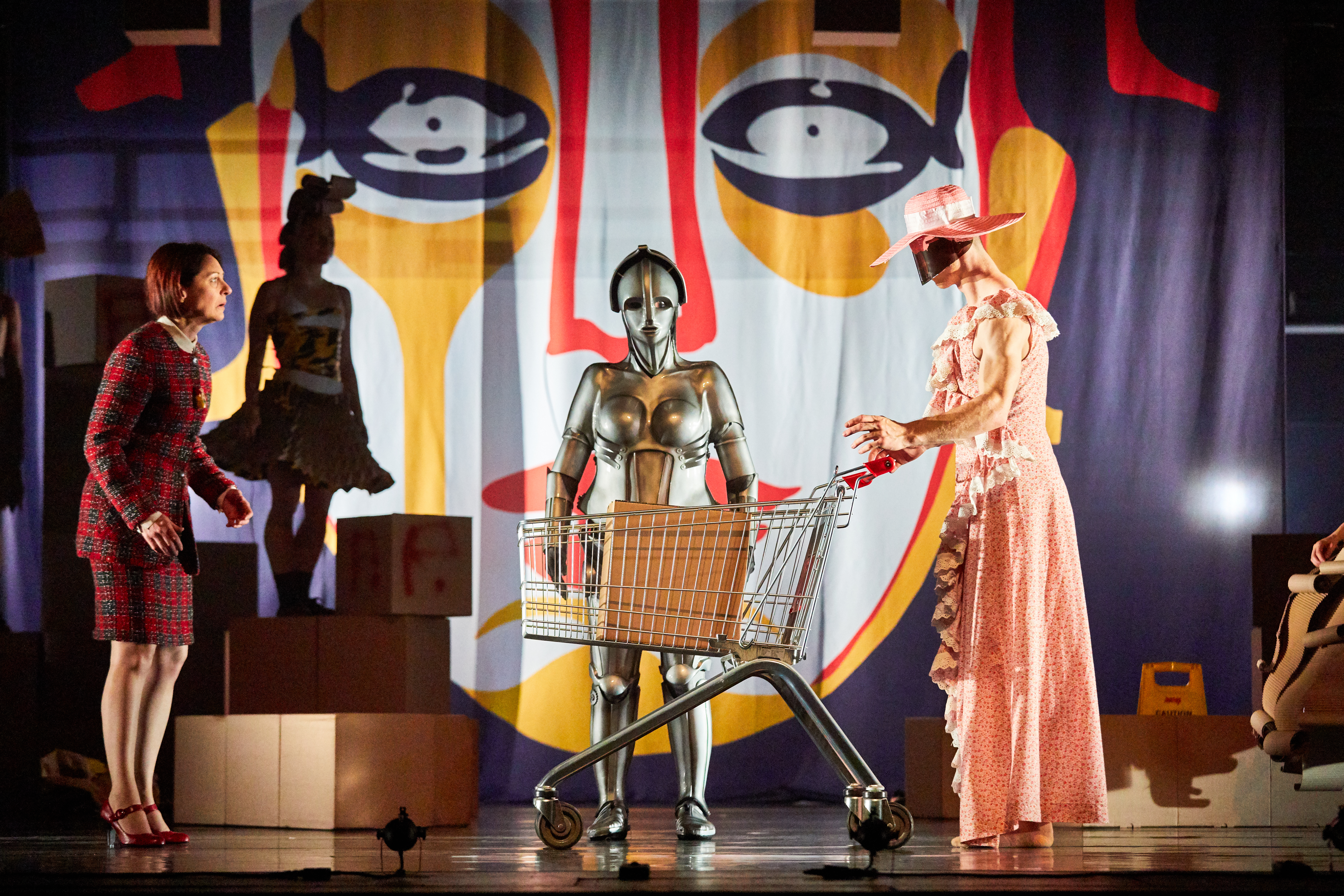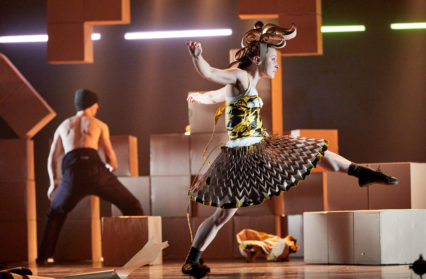No stranger to delivering ambitious, theatre over multiple performance spaces, Marc Rees directs this new imagining of the 1917 ballet, P.A.R.A.D.E.
Born of the now legendary creatives Jean Cocteau, Erik Satie, Pablo Picasso and Sergei Diaghilev, the original Parade was first performed by the Russian dance company, Ballets Russes, one-hundred years ago. Taking its part-Russian origins within the year of revolution as cue, a reimagining of this seminal, surrealist cultural event is the centrepiece of arts in Wales’s commemoration of the Russian Revolution.

Just as the original, this show starts outside the theatre. We wait expectantly in Roald Dahl Plass for some kind of circus (as with the former), but are instead addressed by a bi-lingual politician with an uncanny resemblance to Plaid’s current leader. The notion is that we are workers from the factory behind her (the WMC). The moment of interest in this promenade section is a silver robot akin to the iconic Machine Person from the iconic 1927 Fritz Lang film Metropolis, floodlit on the WMC’s roof before walking the building’s vertical wall. Hoping that P.A.R.A.D.E. will eventually be a spectacle, there is an impatience for the main dance event to make this happening worthwhile and to relieve the audience of their awkward, required flag waving role in this construct.
Next, we are led into the building. In the foyer, community performers from Rubicon Dance, are workers in overalls, processing cardboard boxes in repetitive tasks. There are boxes also at the far end of the building, stacked to make a long wall that I see as a nod to Picasso’s original cardboard box costume designs. Gliding wistfully around the wall are carefree shoppers, drunk on consumerism as they push their shopping trolleys. The inference is that this pleasure is made possible by the not-as-yet automated, factory processes further along. This Stepford Wives sequence is soothing, perhaps intentionally pacifying, as the bearded men as blinkered-eyed housewives, daydream. It is indeed a modern quandary to recognise both sides as slaves to consumerism. Is automation such a bad thing? If we could address job loss through exploring a Universal Income perhaps? A conversation for another day.
Upstairs, now seated in the auditorium, it’s a little disappointing, despite the topical humour, to be addressed by the politician again for several minutes. Once the main course actually begins, with the BBC National Orchestra of Wales performing Satie’s sparse, inventive score, the scene is set for what grows to become a wildly, fascinating production.
The high, box wall stretches across the stage in a factory setting. Workers look busy but soon, cracks in the monotony appear. Play and imagination start to take over, expressed through a lexicon of movements so removed from the usual that they utterly thrill. Renowned choreographer Caroline Finn has excelled herself here.
What seems like the horse-play of a bored worker with parcel tape, or the climbing in and out of boxes, is soon shown to have more direction. People are refocusing, following the call that is within us all to create. Attention continues to dart from one to another, and most audience members would be thwarted by an inability to closely watch all, in the same moment. Eventually, the new creatures born of fun and discovery emerge, fully formed in exquisitely designed card and paper costumes, surely trumping the Spanish genius’ originals. They are circus creatures. Hopefully their presence serves a greater significance than a distraction for the oppressed. The political set love bread and circuses.
The finale sees the ways part as the robot clomps its way to centre stage with a declaration. Drawing the threads together, both the politician and a Stepford Wife with her trolley, flank the creature and a worker acts to humanise it.
With so many elements involved in this production, all pale beside the actual ballet/dance which shines. The original version used the outdoors section to invite onlookers to the circus within. Responding to the seemingly half-formed qualities of today’s Plass section, I would probably have walked past.

To the detriment of P.A.R.A.D.E.’s successes, the emotional heart of the evening is Tundra, a new dance by Spanish guest choreographer Marcos Morau that, oddly, takes the headline slot of the evening, with no fanfare. Every single part of this production is ethereal, heart-stopping magic. The soundscape, woven of Russian folk music, an Icelandic Poem, occasional icy blasts of air and electronic humming, frames a relentlessly intense ensemble piece. The movements are small and tight, with each replicated by an adjacent dancer to cause a rippling. A darkened stage, lit only by a fluorescent tube rectangle over the small, performance platform and an occasionally opening white fissure behind them, eight dancers in identical, folk-knit patterned unitards draw us into a meditative state, as we watch hypnotic patterns of movement. The result is almost trance-inducing and reinforced by the wonderfully evocative sounds. At one point between sequences, the dancers sit and light snow falls from above to take us all deeper, into arctic other-worldliness. At its close, a mass exhale and full shouts of extended appreciation warm our hands and faces once more, returning us to where we began.
Highlights from P.A.R.A.D.E. will be broadcast on BBC Four on Sunday, 5th November at 22.40.
P.A.R.A.D.E is a collaborative production between National Dance Company Wales and Marc Rees
In collaboration with BBC National Orchestra of Wales, Rubicon Dance and Dawns i Bawb












